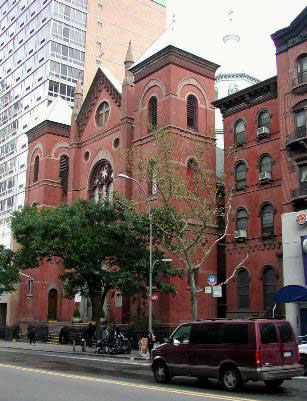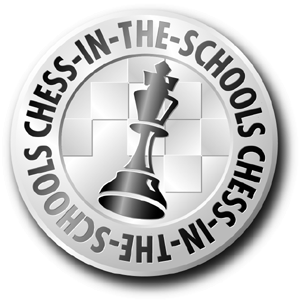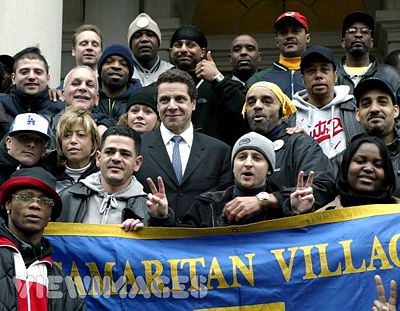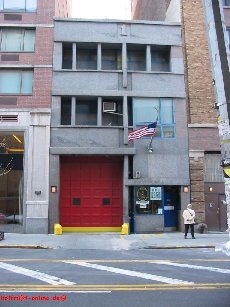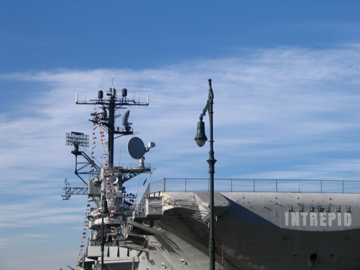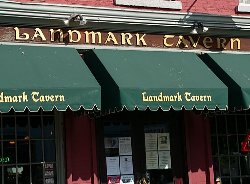From The Peopling of New York City
Contents |
Churches
Hell’s Kitchen boasts a variety of religious denominations and institutions including Scientology, Judaism, Presbyterian, Episcopal, Roman Catholic, Baptist, Lutheran, Greek Orthodox, Evangelical, Seventh Day Adventist, as well as a seminary. This element of Hell’s Kitchen solidifies its status as a Manhattan neighborhood, as opposed to yet another commercial district. Although certainly there are churches throughout Manhattan and greater New York City, the presence of so many churches in such a small area also assists in the creation of a past-meets-present environment. The juxtaposition of 1800’s architecture with modern construction completely defines the nature of Hell’s Kitchen/Clinton.
Educational Services
The educational institutions of Hell’s Kitchen are equally as important to the community as are their religious centers. Beyond public and private schools, the community has instituted a variety of programs aimed at improving the lives of the youth in Hell’s Kitchen. Pre-schools such as the 43rd street Pre-School provides after-school services as well as aiding working parents in the quest for childcare for the very young. The Youth Opportunity Centers at 247 W. 54th Street is likewise designed to keep young children off the streets and out of trouble. Similar institutions include the Jobs For Youth, Inc at 312 W. 36th Street, the W. 59th Street Recreation Center,the I Have A Dream Foundation at 330 7th avenue, The Urban Dove at 458 W. 37th Street, S.I.I.P. of New York at 213 W. 35th Street, the Reading Reform Foundation of New York at 333 W. 57th Street, Chess-in-the-Schools at 353 W. 46th Street, the Boys and Girls Clubs of America at 3. W. 35th Street, the Arts Connection, Inc at 120 W. 46th Street, and the Manhattan Youth Opportunity Center at 246 W. 54th Street. hese intuitions serve the community by keeping the streets safe for children and families alike. The variety of services subsequently provides many job and volunteer opportunities within the neighborhood and allows for the community to take a proactive attitude toward keeping the neighborhood safe and welcoming for children and adults alike.Health Based Organizations
Other institutions in the community exist for a variety of other purposes, but mainly to increase the well being of the neighborhoods constituents. Support for recovering addicts and those battling with substance abuse can be found at neighborhood institutions such as the Jewish Board of Family and Children’s Services at 120 W. 56th Street, Under 21 at 461 W. 41st Street, The New Vision Program at 415 W. 51st Street, the Tri Center, Inc. at 575 8th Avenue, The Center for Children and Families, Inc. at 448 W. 47th Street, the Samaritan Village, Inc. at 327 W. 43rd Street, First Steps to Recovery, Inc. at 312 W. 47th Street, and the Daytop Village at 54 W. 40th Street, among others. For the disabled, resources and support are available through The Association for Help of Retarded Children at 601 W. 50th Street, The Center For Family Support at 440 W. 41st Street, the Office of Vocational and Educational Services at 116 W 32nd Street, The Fountain House at 425 W. 47th Street, the Heartshare Human Services of New York at 400 W. 43rd Street, the Holland House at 351 W. 42nd Street, the Independent Living Association at 317 W. 48th Street, Urban Pathways at 575 8th Avenue, and the YAI National Institute for People With Disabilities at 460 W. 34th Street.
Crisis Centers
The area also contains a number of crises oriented organizations including the Center for Children and Families at 300 W. 43rd Street, the Crisis Center of Covenant House at 460 W. 41st Street, the Red Cross Emergency Family Center at 515 W. 41st Street, the Rheedlen Place at 457 W. 51st Street, and The Streetwork Project at 545 8th Avenue.
Importance
These community institutions provide a number of services, and yet they all have the ambition: to provide for those in need. Especially in the wake of 9/11 where many New Yorkers were left with physical and mental traumas, places such as the September Space at 520 Eighth Avenue, as well as many of the organizations already listed, serve to alleviate the struggles that have become chronic difficulties in the lives of survivors. Even for those not suffering in the aftermath of 9/11, these institutions among others provide the support needed to cope with a vast number of situations. These organizations provide an example of the compassionate and caring side of New York, and the sheer number in Hell’s Kitchen alone illustrate how important community health is to the residents of this West Side neighborhood.
Architecture
Henry Hudson Hotel- 1929
- Benjamin Wistar Morris
- Began as a club for young women, later officer’s quarter’s in WWII
- 353 W 57th Street
Church of St. Paul the Apostle
- 1876
- Jeremiah O’Rourke, completed by George Deshon
- Largest “un-cathedral” in America.
- SW Cor. W 60th Street
St. Luke’s/Roosevelt Hospital Center
- 1990
- Skidmore, Owings and Merrill
- Hospital
- Tenth Avenue between W. 58th and 59th streets
Model Tenements for New York Fireproof Tenement Association
- 1900
- Ernest Flagg
- One of the first tenement buildings to use fireproofing technology
- 500-506 W. 42nd and 569 Tenth Ave between W. 41st and W. 42nd streets
Rescue Company No. 1. NYC Fire Department
- 1988
- The Stein Partnership
- Replaced a fire house that had previously burned down
- 530 W. 43rd Street
New Dramatists
- 1880’s
- Originally a church that has been transformed into a performance space
- 424 W. 44th Street
Film Center Building
- 1928-1929
- Ely Jacques Kahn
- Typical Art-Deco appearance with an elevator lobby
- 630 Ninth Ave between W. 44th and W. 45th streets
Manhattan Plaza
- 1977
- David Todd & Associates
- Intended to provide space for performing artists and to also hasten the development of “Clinton” as a new community
- W. 42nd to W. 43rd between Ninth and Tenth Avenues
The Intrepid
- WWII Aircraft
- More tourist attraction that true architecture, the boat has become a museum and public spectacle.
- 1 Intrepid Plaza; Pier 86 at W. 46th Street
St. Clement’s Church
- 1870
- Edward D. Lindsey
- An unusual building sharing traits form both Victorian and Gothic periods
- 423 W. 47th Street
Playground, NYC Department of Parks & Recreation
- 1974 Michael J Altshuler
- Reconstruction of a typical playground to include mosaics, murals, and community flavors
- W. 45th to W. 46th Streets between Ninth and Tenth Avenues
Landmark Tavern
- 1868
- Still very much representative of the area in which it was created.
- 626 Eleventh Avenue at W 46th Street
High School of Graphic Communication Arts
- 1959
- Kelly & Gruzen
- First escalators used in a high school; also an extremely Internationally oriented flair to spark the new “Clinton”
- 439 W. 49th and 50th street between Ninth and Tenth Avenue
References
- Local Services
- http://www.fadingad.com/020.jpg
- http://www.holfri.de/Fotos/Firehouses/119_1918.JPG
- http://www.nycbeer.org/Images/landmark.jpg
- http://www.nycago.org/Organs/NYC/html/HolyCross.html
- The Samaritan Village
- http://www.nyc.gov/html/sports/html/mayorschess.html
- AIA Guide to New York City. 4th Edition.Three Rivers Press 2000.
